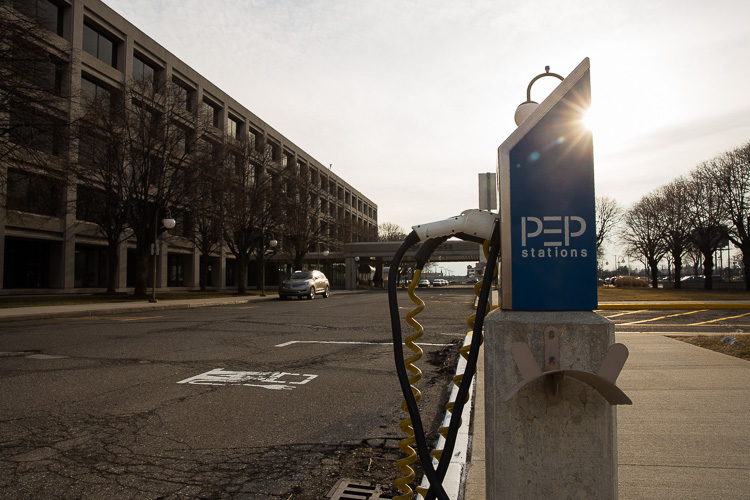Autonomous vehicles will impact the environment in metro Detroit. But how?
As the Detroit region leads the charge in electric, connected, and autonomous vehicle innovation, environmental stakeholders are asking questions about how a radically new way of moving people, goods, and services will impact the environment.


This feature is courtesy of Driven, the story of how the Detroit region is leading the world in next-generation mobility.
As more connected, autonomous, and electric vehicles hit the roadways, there’s no doubt there will be an impact on the environment. But just what that effect will be depends on a slew of factors, from how people utilize mobility services to how automakers equip their vehicles.
At first glance the environmental benefits seem obvious—electric cars don’t spew air-polluting emissions and connected and automated vehicles (CAVs) increase efficiency and traffic flow. But experts warn that there are potential negative effects from these technologies as well, and a lot depends on people’s travel behavior.
“The book is open on that today,” Richard Wallace, director of transportation systems analysis for the Center for Automotive Research (CAR) in Ann Arbor, says of the environmental question. “There’s certainly the potential for both positive and negative impacts, and how it’s adopted is going to be a deciding factor. It’s almost tied more to how mobility services evolve and how we use those.”

Researchers in Michigan and beyond are studying how a wide range of factors can play into how these technologies can help or hurt the environment.
For example, when vehicles communicate with street lights and other infrastructure in order to automatically accelerate and decelerate in a gradual fashion, it cuts down on idling time and congestion, reducing greenhouse gas emissions from gasoline vehicles and energy use from battery-powered cars.
But the computers and sensors installed on CAVs reduce those environmental benefits because of their added weight, energy drain, and aerodynamic drag, according to a recent study from the University of Michigan. Still, the same study found CAVs could reduce energy and emissions by up to 9 percent compared to conventional vehicles taking all that into consideration.
CAVs also should reduce the number of crashes, which hurt the environment by causing traffic backups and resulting in the repair or replacement of vehicles.
Ridesharing? Or single seat shuttles?
An even bigger factor is how the CAVs are used. The best-case scenario for the environment is one where a fleet of connected and autonomous cars are used for mobility services so people can forgo owning their own cars and instead share rides, thus cutting down on the number of cars on the road as well as total vehicle miles traveled.
But current ridesharing behavior offers some problematic issues, notes Simon Mui, senior scientist at the Natural Resources Defense Council. Some people are opting for the convenience and low cost of rideshare services like Uber and Lyft instead of taking public transit, biking or walking to their destination. Uber and Lyft’s carpool services are a move in the right direction, and it’d be even better if people used them in conjunction with public transit, Mui says.
The worst-case scenario could look like a scene from the animated film Wall-E, where everyone gets shuttled around in their personal autonomous vehicle and essentially doubles their driving. As the technology becomes more affordable it can be deployed to individually owned vehicles and people could end up sending them to run errands for themselves.
“Or I go to the movies in the city … and instead of paying for parking, I just tell my car to go back home and park there and then I’ll call it again to pick me up at a certain time,” Mui says.
That kind of behavior would do more than just pollute the air, it would alter urban environments, increase congestion and create sprawl, says Soren Anderson, economics professor at Michigan State University who focuses on energy and environmental economics.
How green these new services and technologies turn out also depends on whether they’re using gasoline or electric vehicles (EVs). Anderson points to research that suggests for now, EVs can actually cause more environmental damage than regular cars depending on when and where they’re charged.

If someone charges a car at night in the Midwest, the power could come from a coal plant that has to ramp up extra generation to meet that electrical load, which is a lot dirtier than someone charging a car during peak hours in California, where the electricity is more likely to come from a natural gas generator.
More than individual choice
As more people switch to EVs, a lot depends on whether utilities opt for renewable power sources as they ramp up generation to meet higher electrical load demand.
There’s already a “powerful shift” away from coal toward more renewable power and smarter electric grids, says John DeBoer, director of new business for Siemens Energy Management Division. Since the transportation sector accounts for more than a quarter of U.S. greenhouse gas emissions, electrifying vehicles can significantly improve air quality.
“One of the most critical things that we’re also seeing is the transportation electrification of fleets,” DeBoer says. “Be that in the medium duty segment, for postal and transit, and all the way to cities, to the electrification of buses, be it for public transport or schools.”
While companies like Siemens are studying environmental impacts of vehicle electrification and other transportation changes, much of the conversation among stakeholders seems to be more focused on developing the technologies and building the market.
The Michigan Public Service Commission has hosted conferences on electric and alternative fuel vehicles in the last several months, but Anderson, who attended one of the conferences as an MSU professor, got the sense that environmental issues aren’t being scrutinized as much.
“I haven’t actually seen a lot of thinking about how it’s going to interact with the environment,” Anderson says. “Everyone is kind of assuming it will be good, because in the back of their mind, they’re thinking, ‘Well we’re going to eventually stop building coal and natural gas and we’re going to eventually be replacing that with solar and wind.'”
Visit Driven and learn how the Detroit region is leading the world in next-generation mobility.
All photos by David Lewinski.




